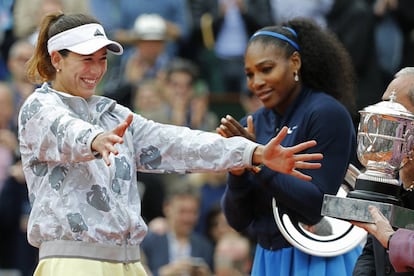Serena Williams, the powerful woman who inspired me
She has left her mark on all of us and moved the sport forward. She’s always been a pioneer. She entered the tennis world wanting to reign a space historically dominated by white players

Serena Williams is a tennis player from another dimension; she’s unique and incomparable. In my own case, she has been an inspiration and a true role model to follow in my career, as she no doubt has been for many other players as well. I started playing tennis at a club that was, of course, unlike the settings where I play now. It was a different world. And I remember my mother saying: “Look at the Williams sisters. Look at the character and grit with which they play. You have to play like that and be like them. Someday you will be like them, Garbiñe.” At the time, I was a little girl, six or seven years old, and Serena and Venus were already playing and winning Grand Slams.
From that moment on, I started to really dream big and to think that if I had character like that, I could become like Serena. It didn’t matter where you come from, whether you’re from South America or anywhere else, whether you’re white, Black or Asian. Your origins and the color of your skin weren’t important. What mattered was that power Serena transmitted. She has left her mark on all of us. Many of us have identified with her, either because of her story or because of the message she has conveyed, which always went beyond the court. Her heart is what has really influenced me. It has often made me train harder and motivated me to keep going.
I must confess that recently, after reading the news of her retirement, I shed a few tears. I cried when she told us she was retiring, which is very rare for me. Somehow, her goodbye has shut down something inside me; something was extinguished. When she announced that it was time to evolve and take the next step, which is only logical and perfectly fine, I thought: No, Serena’s leaving! Now what? Now who’s going to be the one to really lead tennis, to be an unmatched role model that we can look up to? Who will take on the legend’s mantle?
That’s how much she means to me. Yes, we have played against each other, and we spent many years together on the circuit as competitors; when competing against Serena, I have been able to set aside my admiration for her. Ultimately, the game is the only thing that counts in those moments, and you go for it. You do it, respectfully, but you go for it. Measuring up against her on the court is the ultimate goal. We have all dreamed about it.
Serena has always been my role model because she transformed tennis. There are those who’ve been inspired by Sharapova or other great players, but Serena’s the one who definitively changed the game. Not only has she dominated the sport for many years, but she has pioneered a powerful and aggressive style that blew away the previous generation, which played more tactical tennis. Serena took the game by storm and turned it into another type of sport, one that’s more aggressive, stronger, faster and more explosive. From that point on, players all had to adapt if they wanted to compete at her level, or at least close to it. For all these reasons, she’s the greatest of all time. There’s no doubt about it.
Players such as Martina Hingis or my coach, Conchita Martinez, played a slower, more strategic and probably more skillful type of tennis; their style may have been showier, but it was less effective than Serena’s dominant stroke. When she burst onto the scene, she created a “before and after” that forced us to be better. All of us, including me, have studied her game in depth. I’ve watched a thousand videos, a thousand matches, a thousand explanations about her technique, her forehand, her backhand. That’s the only way to face the tennis player who has blazed a new trail.
Her game’s impact has been proportional to her personality. Over time, intimidation has been her best weapon; she has had better or worse performances, but she has never lost the power and inner strength that have gotten her out of so many jams. She’s probably learned all this from her experiences, from all the difficulties she’s had to face since she was a child, including racism. She has had to wear very strong armor and to feel that nobody could ever make a fool out of her. I experienced that sensation very strongly when I played against her for the first time in Melbourne. I felt intimidated, but I learned to face her, and I’ve been able to compete against her fearlessly and on equal terms.
Now, I’m going to reveal something that I’ve never said before. I didn’t want to open up so much about Serena until her retirement was confirmed, and I knew that we would not meet ever again on a tennis court; ultimately, we’re opponents, and I wanted to protect myself.
As you know, I have never looked at tournament draws. But why not? In 2013, I played my first Grand Slam match at the Australian Open. I looked at the draw and saw that I could play Serena in the second round. The first match went so poorly, and I was so angst-ridden that I almost couldn’t play because of all the thoughts that were racing through my mind at the time. I was thinking, “if I win, I’m going to play her” – a moment that I’ve been preparing for my whole life, from the time I first picked up a racquet in Venezuela. Knowing that I might play against Serena affected me so, so, so much that I had to go to a third set against Magdalena Rybarikova in order to win 14-12. Then, against Serena, I had already played the match so many times in my mind that, when the moment came, I was exhausted and couldn’t even move. I lost decisively: 6-2 and 6-0. When I left the court, I told myself: “I’ll never look at another draw.” Since that day, I have preferred to not think any further ahead; she is the reason why.

Serena is revolutionary: for her image, for what she wears, for the fact that her body type differs from the typical tennis physique, and because she has reigned supreme in a sport that has traditionally been dominated by white people. She came into the sport hungry and eager to take over; perhaps that didn’t sit very well with many tennis people. Each time she stepped on the court, everyone watched how she was going to come out, what her attitude was going to be, what outfit she was going to wear. In that sense, she’s been a master of suspense. Despite her many years on the tennis circuit, we know relatively little about her as a player because she doesn’t share that much. Basically, she appears and disappears.
She is a controversial woman who, when she does something, she does it full throttle. She grows in the face of adversity: the more she has been criticized, the more she has reaffirmed herself. She’s become stronger, more groundbreaking and more rebellious. She is an iconoclast who has broken all the molds.
Tu suscripción se está usando en otro dispositivo
¿Quieres añadir otro usuario a tu suscripción?
Si continúas leyendo en este dispositivo, no se podrá leer en el otro.
FlechaTu suscripción se está usando en otro dispositivo y solo puedes acceder a EL PAÍS desde un dispositivo a la vez.
Si quieres compartir tu cuenta, cambia tu suscripción a la modalidad Premium, así podrás añadir otro usuario. Cada uno accederá con su propia cuenta de email, lo que os permitirá personalizar vuestra experiencia en EL PAÍS.
¿Tienes una suscripción de empresa? Accede aquí para contratar más cuentas.
En el caso de no saber quién está usando tu cuenta, te recomendamos cambiar tu contraseña aquí.
Si decides continuar compartiendo tu cuenta, este mensaje se mostrará en tu dispositivo y en el de la otra persona que está usando tu cuenta de forma indefinida, afectando a tu experiencia de lectura. Puedes consultar aquí los términos y condiciones de la suscripción digital.
More information
Archived In
Últimas noticias
Maduro pleads not guilty before the federal court in New York: ‘I am still the president of Venezuela’
A new test can detect Alzheimer’s from a finger prick
UN team enters Sudanese city of El Fasher after paramilitary massacre: ‘It’s like a ghost town’
A recipe for resistance: Indigenous peoples politicize their struggles from the kitchen
Most viewed
- Gilles Lipovetsky: ‘If you want to live better and fall in love, take Prozac, don’t look to philosophy’
- Alain Aspect, Nobel laureate in physics: ‘Einstein was so smart that he would have had to recognize quantum entanglement’
- Alvin Hellerstein, a 92-year-old judge appointed by Bill Clinton, to preside over Maduro’s trial in New York
- Why oil has been at the center of Venezuela-US conflicts for decades
- Cuba confirms death of 32 of its citizens in the US attack against Venezuela










































